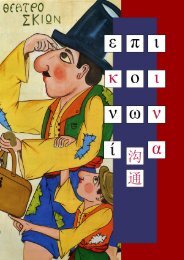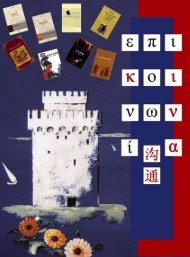Fifth Issue
Fifth Issue
Fifth Issue
You also want an ePaper? Increase the reach of your titles
YUMPU automatically turns print PDFs into web optimized ePapers that Google loves.
compared to the other theater genres – language is the major factor that shapes the spirit<br />
of the performance, embodies ideas in the speech act and gives emphasis to the qualities<br />
of the figures.<br />
Furthermore, an important difference between Karagiozis and his Turkish<br />
counterpart, Karagoz, can be traced in the level of language usage. Karagiozis is free<br />
from the obscene language of Karagoz, and the liberation from this style adds to the<br />
essence of Karagiozis as a highly differentiated style of the Shadow Theater.<br />
The transition from the Turkish to the Greek Shadow Theater was a gradual<br />
process along three basic phases.<br />
In the first period (1850 – 1880), the Turkish element is still prominent. Inspired<br />
by life events or mythology, the early plays are Turkish and the themes and structure are<br />
similar to those of Turkish Karagoz. The gradual presentation of everyday life situations<br />
that are common for Greeks, and the introduction of themes based on Greek folk tradition<br />
reveal the first steps of adjustment to Greek reality, but, still, the new genre presents an<br />
entirely different thematic content from contemporary theater plays.<br />
In the second period (1880 – 1910), the creation of many new Greek plays –<br />
comedies and heroic plays – marks the beginning of the hellenization process, which<br />
occurs through an interactive process of communication between the player and his<br />
audience. By the end of 19 th century, Greek Shadow Theater is a well established<br />
20






